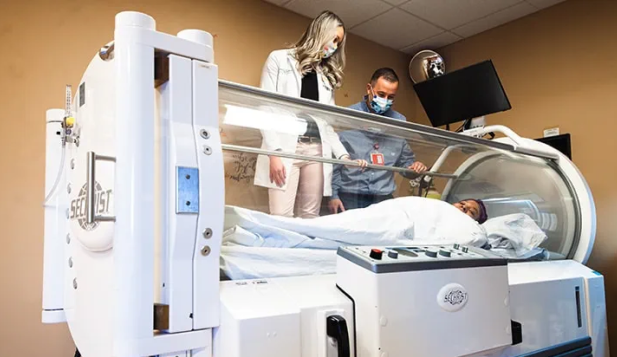1. Diabetic Foot Ulcers & Non-Healing Wounds
One of the most well-supported uses of HBOT is in treating chronic, non-healing wounds — particularly diabetic foot ulcers, which pose a high risk of infection and amputation. hyperbaricmedicalsolutions.com+3PubMed+3PMC+3
Clinical trials and meta-analyses suggest that HBOT can speed healing, reduce the need for amputations, and improve outcomes when combined with standard wound care (e.g. debridement, offloading, infection control). PubMed+1
Anecdote / case: A patient referred to us (or hypothetical) with a diabetic ulcer unresponsive to months of care, after 30 sessions of HBOT showed marked reduction in ulcer size, improved tissue granulation, and avoided major limb amputation.
2. Radiation Injuries & Soft Tissue Damage
Radiation therapy, while life-saving for many cancers, can cause collateral tissue damage (radiation necrosis, fibrosis, poor vascularization) in the surrounding healthy tissues.
HBOT helps by promoting angiogenesis, reducing fibrosis, and improving oxygenation in irradiated tissue that is underperfused. hyperbaricmedicalsolutions.com+4inova.org+4PMC+4
For patients suffering pain, ulceration or tissue breakdown after radiotherapy (for example, in head & neck cancer, pelvic radiation, breast reconstruction), HBOT has been used to ameliorate symptoms and enhance healing.
3. Neurological Injuries & Brain Health
The brain is highly oxygen-sensitive. When injury or ischemia reduces blood flow, neuronal function can be impaired. HBOT may help by improving oxygen delivery, reducing inflammation, and possibly promoting neural repair or neuroplasticity. Harvard Health+3PMC+3PMC+3
Studies and pilot trials have explored HBOT for: traumatic brain injury (TBI), stroke rehabilitation, chronic traumatic encephalopathy (CTE), and cognitive decline. While data are evolving, the early signals are encouraging. PubMed+3PMC+3PMC+3
At Innovative HBOT, we evaluate neurological cases carefully and often combine with physical and cognitive therapies to optimize recovery.
4. Long COVID / Post-Viral Fatigue
Long COVID (or post-acute sequelae of SARS-CoV-2) leaves many patients struggling with fatigue, brain fog, exercise intolerance, and lingering organ damage. Emerging studies suggest that HBOT may help by restoring oxygenation in tissues, reducing systemic inflammation, and mobilizing repair cells. Yale Medicine
In one randomized, double-blind trial of 73 Long COVID patients, those receiving HBOT (versus placebo) showed improvements in attention, sleep quality, pain, and energy. Yale Medicine
Though still investigational, HBOT is a promising adjunct for patients whose symptoms persist despite conventional care.
5. Infections, Osteomyelitis, Necrotizing Wounds
Severe infections — particularly those with hypoxic, necrotic tissue (e.g. necrotizing fasciitis), gas gangrene, or osteomyelitis — pose a serious challenge as impaired oxygenation limits immune and antibiotic efficacy. uhhospitals.org+3PMC+3PubMed+3
HBOT increases oxygen levels in infected tissues, supports immune cell function, and can directly inhibit anaerobic bacteria. When used as an adjunct to surgery and antibiotics, outcomes improve. PMC+1
Case note: A patient with chronic osteomyelitis unresponsive to extended antibiotic therapy underwent an HBOT protocol combined with surgical debridement, leading to reduction in bacterial load and better bone healing.
Caveats & Limitations
- Not all uses of HBOT are strongly evidence-based (e.g. Alzheimer’s, autism, cancer) — these remain experimental. Harvard Health+2hyperbaricmedicalsolutions.com+2
- Outcomes are better when HBOT is used as adjunct therapy, not a standalone “magic bullet.”
- Patient selection, timing, and protocol (pressure, duration, number of sessions) matter a lot.
- Cost, accessibility, and reimbursement are practical constraints for many patients.
How Innovative HBOT Approaches These Conditions
At Innovative HBOT, we adopt a patient-centric, evidence-based approach:
- Comprehensive evaluation and selection of cases where HBOT is likely to add value
- Tailored treatment protocols (pressure, session count) rather than one-size-fits-all
- Monitoring and follow-up, including imaging or wound assessments
- Integration with standard care (surgery, physical therapy, medications)
- Transparent reporting of results and patient feedback
Our goal is to maximize benefit while minimizing risk and cost.

